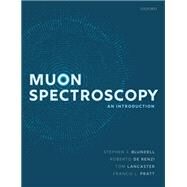Muon Spectroscopy An Introduction
, by Blundell, Stephen J.; De Renzi, Roberto; Lancaster, Tom; Pratt, Francis L.- ISBN: 9780198858959 | 0198858957
- Cover: Hardcover
- Copyright: 2/10/2022
Stephen J. Blundell, Professor of Physics, University of Oxford,Roberto De Renzi, Professor of Physics, University of Parma,Tom Lancaster, Professor of Physics, Durham University,Francis L. Pratt, STFC Fellow, ISIS Neutron and Muon Source
Stephen J. Blundell is a Professor of Physics at the University of Oxford and a Professorial Fellow of Mansfield College, Oxford. He leads a research group which uses muon spectroscopy to solve problems in magnetism and superconductivity and he has been developing ab initio techniques to understand
the nature of the muon site.
Roberto De Renzi is Professor of Physics at the University of Parma. He started developing muon spin spectrometers at CERN in 1980 and later took part in the design of the ISIS Muon Facility. He currently leads a µSR and NMR group dedicated to the experimental investigation of magnetic and
superconducting compounds, and to the application of ab-initio techniques to assist the measurement of condensed matter properties based on the experimental detection of hyperfine fields.
Tom Lancaster was a research fellow at the University of Oxford before taking up a lectureship at Durham University in 2012, where he is currently Professor of Physics. His research group's interests include using muons to investigate low-dimensional, topological, and molecular magnetism, and the
nature of the muon stopping state.
Francis L. Pratt is a senior scientist and STFC Fellow based in the muon group at the ISIS Neutron and Muon Source. He has worked in muon spectroscopy for more than thirty years, using experimental facilities in the UK, Switzerland, and Japan. His research interests are focused on condensed matter
physics using muons, with topics ranging from the study of quantum magnets and spin liquids to organic magnets and superconductors and the physics of molecular systems.
1. The Basics of µSR
Part I: Elements of Muon Spectroscopy
2. Introduction
3. Muon Charge and Spin States
4. The Quantum Muon
5. Polarization Functions
Part II: Science with µSR
6. Magnetism
7. Dynamic Effects in Magnetism
8. Measuring Dynamic Processes
9. Superconductors
10. Semiconductors and Dielectrics
11. Ionic Motion
12. Chemistry
Part III: Practicalities of Muon Spectroscopy
13. Making Muons
14. Instrumentation
15. Doing the Experiment
Part IV: Further Topics in Muon Spectroscopy
16. Calculating Muon Sites
17. Numerical Modelling
18. Low Energy µSR
19. Stimulation Methods
20. High Magnetic Fields
21. Muons under Pressure
22. Negative Muon Techniques
Part V: Complementary Techniques
23. µSR versus Other Resonance and Bulk Techniques
24. X-rays, Neutrons, and µSR
The New copy of this book will include any supplemental materials advertised. Please check the title of the book to determine if it should include any access cards, study guides, lab manuals, CDs, etc.
The Used, Rental and eBook copies of this book are not guaranteed to include any supplemental materials. Typically, only the book itself is included. This is true even if the title states it includes any access cards, study guides, lab manuals, CDs, etc.
Digital License
You are licensing a digital product for a set duration. Durations are set forth in the product description, with "Lifetime" typically meaning five (5) years of online access and permanent download to a supported device. All licenses are non-transferable.
More details can be found here.






